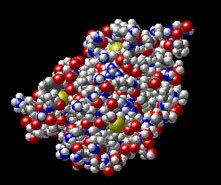I am always amazed at how little food some people eat. Maybe I'm just a glutton, but I could not survive on what some people call meals. A lot of times, people don't even realize they're not eating enough food until I get them to figure out their daily caloric needs with this formula.
Once they do, they're often shocked to see how little they eat.
Use the following formula as a guideline for determining your daily caloric needs. There are more accurate formulas which take into consideration your bodyfat percentage, however I suspect that only a few actually know they're bf% this one will still give a good indication of your needs.
Because it doesn't take into consideration bf% however, it will underestimate your needs if you are overly muscular (hmmm, I didn't know that was possible).

Determine Your Basal Metabolic Rate

First you need to determine your Basal Metabolic Rate (BMR) with the following equation. Your BMR is the total number of calories your body needs if you did nothing but lie in bed all day with no activity at all.
Men:
BMR = 66 + (13.7 X wt in kg) + (5 X ht in cm) - (6.8 X age in years)
Women:
BMR = 655 + (9.6 X wt in kg) + (1.8 X ht in cm) - (4.7 X age in years)
* Note: 1 inch = 2.54 cm and 1 kilogram = 2.2 lbs.
Example:
Male, 27, 180lbs, 5'11"
66 + (13.7 x 81.81kg) + (5 x 180 cm) - (6.8 x 27 yrs) = 1903

In this example your BMR is 1903. Next you need to determine your total daily energy expenditure, which is a fancy way of saying what you need to maintain your weight. Multiply your BMR with the corresponding figure for your activity level.

Activity Multiplier


Sedentary
- = BMR X 1.2 (little or no exercise, desk job)
Lightly Active = BMR X 1.375 (light exercise/sports 1-3 days/wk)
Mod. Active = BMR X 1.55 (moderate exercise/sports 3-5 days/wk)
Very Active = BMR X 1.725 (hard exercise/sports 6-7 days/wk)
Extremely Active = BMR X 1.9 (hard daily exercise/sports & physical job Or 2X day training, i.e marathon, contest etc.)
Example:
BMR = 1903, we'll use 1.725 for a very active individual.
1903 x 1.725 = 3282
So, in this example you need 3282 calories per day to maintain your current weight.

Now What?

Now that you know how to determine your maintenance needs, you can adjust your figures to reach certain goals. If you are looking to gain some weight (hopefully you want muscle) you would eat above your maintenance and if you were looking to lose fat, you'd eat below your maintenance. While everyone is different, a general guideline is to add or subtract 500 cals per day to/from your maintenance.
Some may find that they need to adjust that figure. Be sure to monitor your gains though, if you increase your calories too fast, you will likely gain a lot of fat as opposed to muscle. Similarly, if you drop your cals too fast or too much, you will slow your metabolism down and it will take longer to lose fat.
Knowing your BMR and maintenance requirements is useless if you don't know how to use this information. First off, if you haven't been logging your meals, there's really no way to know for sure how many calories you've been consuming.
You really should log your meals for at least a week before using this information. Secondly, the figures are general guidelines remember. If you've been maintaining your weight at say 2500 cals and you've worked your maintenance out to be 2200, I'd stick w/ the 2500 figure as that's what's been working for you.

Macronutrient Breakdowns

Now, let's talk macronutrient breakdowns. You can manipulate your protein/carb/fat ratios to achieve different goals. For instance, when I cut for a competition, I usually drop my calorie intake and use a 50/30/20 p/c/f split. If I am just maintaining, I might use a 40/40/20 split.
 Whatever split you choose, make sure it works for you. If you're consistently lacking in energy you may need to increase your carb intake, that is assuming you are getting enough calories in the first place.
Whatever split you choose, make sure it works for you. If you're consistently lacking in energy you may need to increase your carb intake, that is assuming you are getting enough calories in the first place.
So what do all these breakdowns mean? Well, now that you've picked a macronutrient split, you can figure out how many grams of each you need. For our example, we'll use 3000 calories a day with a 30/50/20 breakdown.
Both protein and carbohydrates have four calories per gram while fat has nine calories per gram.
3000 x 30% = 900 calories from protein 900 / 4 calories per gram = 225 grams protein per day
3000 x 50% = 1500 calories from carbs 1500 / 4 calories per gram = 375 grams carbs per day
3000 x 20% = 600 calories from fat 600 / 9 calories per gram = 66 grams fat per day
Ok, so now you're armed with all the information necessary to keep your energy levels high, reach your goals and change your body composition if desired. Now I'm going to bring up a food log again. It may seem like a pain in the ass to write everything down, but think of it as an investment.
Not only will you be able to reach your goals much faster than just winging it, but you will eventually get to the point where you know what and how much to eat without having to log at all.
